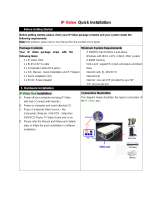LightFrame
TM
3 offers everything that LightFrame
TM
2 has but now with the possibility to enhance
multiple pictures at the same time. So in a web page LightFrame
TM
will find all the pictures and enhance
them simultaneously or in a photo viewing application you can enhance multiple photos at once.
Furthermore LightFrame
TM
3 comes with an easy to activate full screen function. This is especially handy
for games and movies. Just one click on the full screen button and LightFrame
TM
enhances your total
monitor.
Q: Can I upgrade my current Philips monitor to LightFrame
TM
3?
A: No. For LightFrame
TM
3 Philips developed special hardware which is build into the monitor. Therefore
upgrading from LightFrame
TM
1 or 2 to 3 is not possible. It is however possible to upgrade your
LightFrame
TM
1 monitor to LightFrame
TM
2 by installing the LightFrame
TM
2 software.
Q: Can I install LightFrame
TM
3 over an older version?
A: When you install LightFrame
TM
3 the setup wizard will scan your system to check if you have an older
version installed. If so, the setup wizard will remove that version before continuing with the installation of
the new version. Please be aware that for LightFrame
TM
3 you also need a monitor which is capable of
running the LightFrame
TM
3 feature.
Q: How many windows can I enhance at the same time?
A: In LightFrame
TM
3 it is possible to enhance up to 7 windows at the same time. It is however important
to understand that when other windows, toolbars or menus overlap the enhanced windows, the maximum
number of enhanced windows can be less.
Q: How many pictures can LightFrame
TM
enhance in Internet Explorer?
A: In Internet Explorer LightFrame
TM
3 can enhance up to 14 pictures at the same time. LightFrame
TM
3
filters the pictures it finds based on the minimum size of the picture therefore it may happen that some
pictures are not enhanced when you open a web page.
Q: Can I enhance two or more area's at the same time?
A: Yes. With LightFrame
TM
3 you have the possibility to select several windows with pictures and videos
and enhance them at the same time.
Q: Some times my mouse changes to a light bulb with a plus sign and sometimes with a minus
sign. What is the difference?
A: The mouse pointer in the shape of a light bulb indicates that LightFrame
TM
is ready to accept a
selection from you for which window should be enhanced.
If there is a minus sign it means that you are moving over a window where LightFrame
TM
is already
active and clicking this window will switch the enhancement off. A plus sign appears when moving over a
window which is not enhanced and clicking that one will enable LightFrame
TM
on that window.
Q: What is wrong when my mouse changes into a light bulb with a red cross?
A: Nothing. It just means that your mouse moves outside the application where you already have one or
more windows enhanced. You can only select windows with in the same application. The cross indicates
that you move into an area where you cannot make a selection.
Q: Can I use LightFrame
TM
with Netscape?
A: You can use LightFrame
TM
with Netscape, but its functions are limited to manually highlighting the
entire Netscape client window. Since LightFrame
TM
is specifically designed for bright, high contrast photo
file:///D|/C/english/150p4cgbs/product/product.htm (3 of 10) [3/17/2003 7:14:09 PM]






















